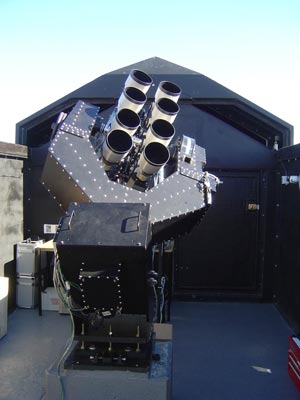Original URL: https://www.theregister.com/2006/09/28/hot_planets/
Astronomers ID hottest ever extra solar planets
Pack high factor sun cream
Posted in Science, 28th September 2006 12:44 GMT
Scottish astronomers working on a new wide-field survey of the sky have identified two new extra-solar planets in the constellations of Andromeda and Delphinius. The planets have been dubbed Wasp-1a and Wasp-1b.
The planets are about the same size as Jupiter, but their orbits lie mere millions of kilometres from their stars, and take only days to complete. The intense solar radiation they endure is stripping them of their atmospheres, and heating them to temperatures of over 1,800°C.

The planets were identified by the so called SuperWasp survey (it stands for Wide Angle Search for Planets), a relatively low budget setup involving several cameras mounted on a telescope in South Africa and on another in the Canary Islands. The cameras combine to provide scientists with a field of view some 2,000 times that of a conventional telescope.
The cameras repeatedly scan the skies looking for stars that change in brightness. This often indicates that another body is orbiting the star, passing in front of the star and reducing the amount of light that reaches Earth.
This transiting, as it is known, is very rare, but because SuperWasp scans such a huge number of stars, the odds of finding transiting planets is vastly increased.
Once a candidate system has been identified, the team works with colleagues in France and Switzerland on the Sophie spectrograph at the Observatoire de Haute-Provence to check any stars flagged as potentially harbouring planets.
The gravity of a companion planet perturbs the orbit of a star, ever so slightly, making it appear to wobble back and forth. It is this motion that Sophie can identify, confirming the presence of a planet.
Once the planet's existence has been confirmed, the team can book time on one of the great space observatories - Hubble or Spitzer, to take a closer look. Studying the planets in infrared, for instance, tells astronomers a lot about the kind of weather that might be expected on the newly discovered worlds.
Professor Andrew Collier Cameron told the BBC: "All the theoretical models tell us that these planets should have dense cloud decks made essentially of 'rock snowflakes'; the sorts of chemicals which condense to form clouds at these high temperatures are things that we normally think of on Earth as minerals - olivine, forsterite, all the magnesium silicates."
The SuperWasp project is set to run for another three years. The team, based at St Andrews University, hopes to identify all the transiting events within the range of the scopes. ®